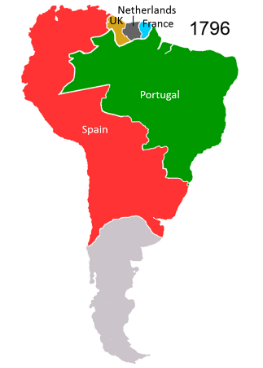5.3: The South American Colonial Landscape
- Page ID
- 21076
A variety of ancient cultures were found in South America prior to colonization. These indigenous groups settled in a variety of environments, some in the coastal plains and others in the Amazon basin. One group, the Inca, primarily settled in the altiplano of Peru beginning in the 13th century. The Inca Empire was the largest of the pre-Colombian, referring to before Columbus’ arrival, civilizations. Initially, the Inca founded the city-state Kingdom of Cusco, but over time, expanded to encompass four territories stretching 2,500 miles and included over 4 million people.
In 1494 CE, Spain and Portugal signed the Treaty of Tordesillas, dividing up territory in the New World between the two colonial empires (Figure \(\PageIndex{1}\)). The Spanish would control territory to the west of the line while Portugal would control territory to the east. Spanish conquistador Francisco Pizarro reached the Inca by 1526 CE. The empire, already weakened by smallpox and infighting, was conquered by the Spanish soon after. Portugal meanwhile conquered much of eastern South America in present-day Brazil.

In coastal South America, France, the Netherlands, and the United Kingdom established colonies (Figure \(\PageIndex{2}\)). These colonial possessions were largely extensions of the Central American rimland with large plantations and slave labor. Portugal, too, established plantations along coastal Brazil. As colonialism expanded, the colonial empires prospered. Lima, for example, in present-day Peru, became one of the wealthiest cities in the word due to its silver deposits.

Colonization dramatically changed the urban landscape of the Americas as well as rural development patterns. Development broadly refers to economic, social, and institutional advancements and levels of development vary widely across the region. In the rural areas of South America, land was taken from indigenous groups, as it had been in Middle America, and transformed to the benefit of colonial interests. The main interest of the conquering group was to extract riches with little thought given to fostering local development and regional connectivity. Even today, many of the rural areas of South America remain highly isolated and the indigenous descendants of conquered Amerindian groups among the poorest in the region.
In cities that were conquered, European colonizers typically razed existing structures and built new ones. In general, there was little regard for local development and cultural values. The Spanish colonies, for example, were governed according to the Laws of the Indies. These laws regulated social, economic, and political life in territories that were controlled by Spain. They also prescribed a very specific set of urban planning guidelines, including building towns around a Plaza Mayor (main square) and creating a road network on a grid system. Even today, the cities of the Americas often look quite European. In Mexico City, for example, the Spanish destroyed the Aztec capital of Tenochtitlan and built the Mexico City Cathedral over the ruins of the Aztec Templo Mayor complex (Figure \(\PageIndex{3}\)).

In the early 19th century, most of the colonies of Middle and South America gained their independence, often led by the Europeans who had settled in the region. Larger colonial possessions often separated into smaller independent states. For a short time, the states of Central America formed a federal republic, but this experiment devolved into civil war. Today, most of the mainland of Middle and South America is independent, with the exception of French Guiana which is maintained as a French territory and is home to a launch site for the European Space Agency. Many of the island nations are still controlled by other countries. France, the United States, the United Kingdom, and the Netherlands all still have territories in the Caribbean.
- Development:
-
economic, social, and institutional advancements


